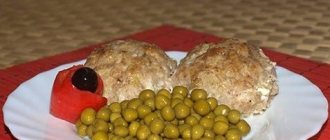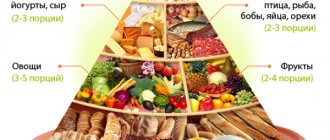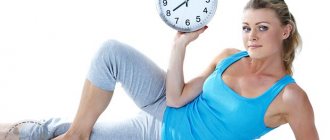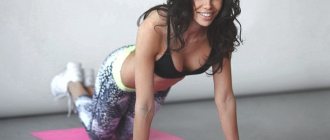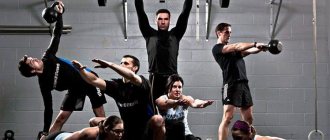Exercising has a beneficial effect on the digestive processes, helping to speed them up. This is due to the fact that the body consumes much more energy during physical activity than at rest or during daily activities. If the diet of a person who has started playing sports, or even doing morning exercises, does not change, then the body begins to consume its own resources. The result of such training will be the opposite of what is desired: the volume of muscle mass will decrease, physical condition will decline, and there will be more and more cases of injuries.
Content
- Training and eating regimen
- Diet and serving size during sports training
- Proteins in an athlete's diet
- Fats in an athlete's diet
- Carbohydrates in an athlete's diet
- Specific needs of the body when playing sports
- Myths about sports nutrition
- Secrets of sports nutrition
The term “sports nutrition” applies exclusively to specialized nutritional supplements. Their manufacturers claim that by taking them, a person can begin active training of any complexity without changing his own menu. This judgment is not justified and smacks of populism. In laboratory conditions, it is impossible to create a product from refined substances that would be fully accepted by the body of every person and replace its daily nutritional needs. Starting sports training requires a review of your diet. Nutritional supplements and vitamin preparations can only be taken on the recommendation of a doctor and trainer.
Myths about the daily routine for weight loss
The topic of a daily routine for weight loss is quite relevant, and a lot of attention is paid to it. That is why there are various myths that people who are losing weight are ready to religiously believe. Let's look at them.
It is forbidden to eat after 18:00
This is the first myth that many people who are losing weight adhere to, relying on the fact that after 6 pm metabolic processes slow down and the food taken is stored as fat. In fact, the human body works all the time, regardless of the time of day. You need to have dinner 2-3 hours before bedtime, taking a short walk after it. It will remove any fears of encountering a “slow” metabolism.
Metabolism is faster in the morning, so you need to eat as early as possible in the morning.
If a person wakes up at 6-7 in the morning and has no desire to eat food, you should not force your body to take it. Most often, it is precisely because of this “need” that there is overeating, eating disorders and a bad mood for the whole day. You should eat only at times when your body really needs it.
Snacking will help reduce hunger and appetite during a full meal.
Snacks do help the body cope with sudden hunger, but they will only be appropriate if there is a physiological need for it.
Daytime naps disrupt nighttime sleep
The fitness world and professional athletes often use a 20-30 minute nap during the day to recover and gain strength for the afternoon. If there is a desire to sleep during the daytime, and there is such an opportunity, 30 minutes of sleep will not harm the body in any way; on the contrary, it will charge you with new energy for activity.
There are many myths regarding the daily regimen for weight loss, all of them are created due to a misunderstanding of this term.
Training and eating regimen
The spinal cord is responsible for the functioning of the muscles of the human body. The tissues of the walls of the digestive organs and muscles have a common nature, but different functions. A large amount of energy is spent on their active activity. They cannot be loaded at the same time. Sports training immediately after eating leads to an imbalance in the coordination of both systems. The receptor signals entering the spinal cord will have completely unrelated information and equally confused commands will be sent in response. As a result, the work of all the muscles involved will be carried out at half strength.
The ideal time gap between eating and the start of sports training is four hours. During this time, food is completely absorbed by the stomach, and the processes of its absorption are still ongoing. You shouldn’t start exercising when you feel hungry. Demanding food, the body will not be able to fully concentrate on performing the exercises correctly. You should not eat immediately after finishing a sports workout. We inherited a brutal appetite after physical exertion from primitive man. After a successful hunt, he had to eat for the future, not counting on a new portion within a day, or maybe even a week. Modern man, following instinct, will simply overeat and overload his stomach.
General rules
All recommendations for getting up and going to bed come down to one thing - you need to go to bed and get up at the same time. Everyone selects this mode based on the characteristics of the work and other factors.
Also, it is important to consider your type (lark, owl, pigeon). You can force yourself to change your mind, but it’s hard and practically useless. The average person wakes up around 6 am, and the body falls asleep around half past ten in the evening.
There are general rules for physical activity:
- Morning work-out. No one has yet come up with anything better than intense physical exercise for 15 minutes before breakfast.
- Gym, swimming pool, home workout before dinner. All doctors talk about training after work as the best time for sports. If work allows, it has been scientifically proven that between 15 and 17 hours the peak of physical activity occurs.
- Walk after dinner. If you turn to scientists for experience, then the best interval for this is between 19 and 20. Intense sports are not needed, simple physical activity will be enough.
Diet and serving size during sports training
A person should make adjustments to his diet from the very day he starts playing sports. At the initial stage, physical activity is minimal, but the body needs a resource, due to which in the future it will be able to maintain tone in order to build it up. An increase in portion volumes can be made, but only slightly. It is dangerous to increase the amount of food consumed at one time by more than 100 grams. Once filled with it, the stomach will increase so much that it can put pressure on other internal organs. The main emphasis should be on introducing the maximum variety of foods into the diet, as well as increasing the volume of specific foods containing substances required for the chosen sport and the nature of the training.
The diet of a person leading an active lifestyle, including sports, should contain proteins, fats, carbohydrates and the maximum amount of vitamins. The latter are necessary not only to replenish the costs that occur during training and keep the body in good shape, but also to protect against viral diseases. Getting used to physical activity, a person becomes less susceptible to pain symptoms, so the onset of a mild cold may not even be noticed. To eliminate the risk of infection with subsequent complications, the diet must be saturated with vitamins.
About training modes
- How much should an athlete train to achieve serious results?
- Why do some athletes grow to the level of national championships, while others remain in the “beginner” status for years?
- The problem of prioritization: is it possible to combine serious sports with other activities?
- Training for yourself or working for results – which is better?
I will try to answer these and other questions in my message.
I would like to start the conversation by talking about training regimes . Without delving into the theory and methods of planning sports training, we can identify two main training modes in which a training group or individual athletes can work: the developmental and maintenance mode of training loads.
During the training process, an athlete masters a certain set of exercises and techniques and, as a result of his practice, receives a stable skill as a result, which can further develop, can be maintained at the required level - or can be lost if the acquired skills are not applied. Yes, of course, everyone knows the analogy with riding a bicycle or swimming - having once learned to ride without losing balance or to stay on the water, a person, as a rule, is able to use this skill even after many years. But is an athlete-cyclist or swimmer, after a long break, able to again show good sports results, as in competitions “in his youth”? Alas, the answer is no.
A large number of people (especially those who caught karate classes at an early stage of its development in our country or who imagine the learning process from films) are sure that martial arts training is a complete “explanation of technique.” The trainer shows miracle techniques, the students watch, listen, and then try to repeat. Well, maybe sometimes they do push-ups or hit weights. The content of the classes remains almost unchanged, only the techniques learned change.
Yes, of course, this approach was common many years ago, when the level of knowledge of the technique was low, and information was collected bit by bit. Perhaps even now in certain sections you can see how instructors talk for hours about the features of a particular technique.
However, sports and competitive practice convincingly proves: training an athlete is a certain technology. And in forceful contact confrontation, technical training is an important, but not decisive component. In Kyokushin karate, the ability to demonstrate the required level of strength, endurance, desire to win and strength of character is no less (and often much more) important. That is why the very process of training in Kyokushinkai is aimed at constant improvement, advancement, and this fundamentally differs from simply visiting fitness rooms “to stay in shape.”
So, an athlete aimed at improving his results must develop his skills. There are entire tables that show when and in what mode it is necessary to train speed-strength qualities, when and how - endurance, or agility, or flexibility... To what extent and how intensively to train, and how long to rest - but we will leave the planning process to the coaches. Let’s outline the main thing: if more than two days pass between training sessions, the athlete will lose most of the training effect. Simply put, for three training sessions a week, a competitive amateur athlete can still gain something. Two workouts per week is the minimum for a maintenance regimen. This is when the athlete has already reached a certain level, but for strategic reasons it is necessary to reduce the training pace. Possible reasons: off-season, when an actively performing athlete needs a break; recovery period after a difficult tournament or injury; a large side load - for example, preparing for an exam at school or university, or other temporary circumstances.
It was not for nothing that I mentioned the phrase “temporary circumstances”. Of course, if a member of the national team needs to reduce the pace of loads and train in a maintenance mode, this will be met with understanding. As well as temporary transfer to another group, substitution of training for less intense ones - this is practiced everywhere. Let's not forget that the usual training regime for a performing athlete is from 4 to 6 workouts per week.
I will make a reservation about the regime of initial training groups (IT). Yes, initially this is two classes a week, but at the stage of familiarization with the subject, with the trainer, the structure of the lesson and the general training format - this is enough for many beginners. For those who find this not enough, they will quickly have the opportunity to study additionally. And as a result, the prospect of changing the NP group to academic and sports. Whoever wants more, we will give such opportunities.
But very often the opposite picture occurs. An ordinary schoolboy, studying in the club for the second or third year. A person who competes, at best, once or twice a year at club tournaments and once a year goes to three-day training camps and exams, begins to attend classes not even three, but once or twice a week. Allows absences due to “poor health” and “family circumstances.” Among the reasons are “visiting a tutor,” “there were a lot of lessons,” and even “parents punished me for my grades and didn’t let me go to karate.” By the way, the last reason is rightly perceived by the coach as personal disrespect: our classes are not a subject for blackmail, and the work of a coach is not an object of bargaining between the child and parents who made omissions in organizing the student’s studies and life. This is fundamental and is not discussed.
So, let us note: every student who has paid the membership fee can theoretically not attend classes at all, or attend one or two classes. Of course, we cannot dictate which tasks will be more of a priority for you and which will be of lesser priority. Everyone sets their own priorities. And even more so, we have no right to insist that a student train when he is feeling unwell; if a person is sick, he must be treated. If parents want their child, in addition to karate, to also attend a music school, a theater group, a swimming pool, a dance studio and a Chinese language teacher, we also cannot forbid parents to have fun in this way.
But a year passes, two, three, and questions arise. A variety of things like this:
- You know, we can’t go to competitions - we have a rehearsal in a music studio. - You say that the child cannot concentrate in classes - but the fact is that today we have eight lessons, and then we also had dancing.
“We were sick here for a week, and then we studied for tests for a week... do we have to pay for the whole month?”
- Tell me, we’re on vacation and we’ll miss a month - is it okay?
— Is it possible to get a belt and not go to training camp? Our finances are difficult right now...
- Why are you excluding us from the national team, although we brought a certificate that we were sick last month?
- Why did the other guys pass the exam, but my son didn’t?
— Why don’t they take us to the All-Russian tournament, while others go?
— Why does our child constantly lose to his peers at club tournaments? Is he incapable or is he training with the wrong trainer?
I can answer each of the questions separately if there is interest. But the very fact that such questions appear regularly indicates a lack of understanding by parents and students of the basic principle on which the result actually depends.
The principle is simple.
Some train five times a week, without skipping, and with full dedication, participate in training camps and competitions, compete with athletes from other gyms, clubs, and regions. They have little free time, but their experience, skills and abilities are growing before their eyes. This is hard but rewarding work. Business, occupation.
Others train 2-3 times a week in the same gym, with the same partners. They don’t participate in club events, but on weekends they go to barbecues with their parents. They have other things to do and activities, “there are no financial opportunities”, they do it “for themselves” and are not going “to big sports” at all; entry-level tournaments are their ceiling. And so - year after year.
But the first ones will compete at the District, Russian, and international competitions; will wear yellow, green, brown belts (and maybe black).
But the second ones are not. There's nothing wrong with that. But the choice must be conscious.
Do we want to squeeze “results at any cost” out of our students? No, our salaries do not depend on medals and titles. But our job is to make people stronger, bolder, more organized, teach them to set goals and achieve them, overcoming difficulties. This is why most people come to sports clubs. But our Path that we follow is not a tourist trip, not a rafting trip, but an ascent to a steep, endless peak, step by step.
It is not suitable for everyone, although it is open to everyone.
(c) Fadeev Roman Igorevich, 03/14/2017
Proteins in an athlete's diet
Protein foods are very important for the formation of muscles and the rapid recovery of the human body after physical exertion. Among its advantages:
- quick absorption;
- high calorie content in small portions;
- participation of the substances contained in it in the processes of hematopoiesis.
Sometimes, in an effort to achieve quick results in the formation of sculpted muscles, in addition to the main diet rich in protein foods, a person begins to take additional protein. The body is able to absorb a certain amount of this substance, so this supplement will not affect muscle growth in any way. Protein in its pure form can be taken if it is not enough in the menu, or to speed up recovery from injuries.
To increase the flexibility of ligaments, some athletes go to the other extreme - they fundamentally refuse protein products. In order not to deplete the diet and not jeopardize the body's endurance, you can simply choose foods that contain a minimum of animal fat. Speeding up the digestion process can also help. In the homeland of yoga and other sports practices that require maximum flexibility, food is seasoned with a large amount of spices to achieve this. This ingredient helps burn fat and quickly digest food.
Fats in an athlete's diet
Eating fats of animal origin is quite justified if training involves heavy loads, as well as prolonged exposure to the cold. All other options for playing sports involve nutrition in which this component will be present in minimal quantities. If physical activity is part of a weight loss program, then it is better to completely exclude animal fats from the diet. The amount of vegetable oils in food also needs to be controlled.
The benefit of unsaturated fats, which vegetable oils are rich in, lies in their high content of substances that:
- have a beneficial effect on metabolism;
- participate in the absorption of a number of vitamins;
— activate the work of the cardiovascular system.
Many types of vegetable oils contain B vitamins necessary for the proper functioning of the nervous system, a number of essential amino acids and minerals. They go great with vegetables. To get the maximum benefit from this product, you should prefer salad,
seasoned with vegetable oil, cutlet fried in it. During heat treatment, this ingredient in dishes loses its properties.
Carbohydrates in an athlete's diet
Carbohydrates, like proteins, are a source of energy for the body. They differ in that they are broken down by the digestive system much longer than proteins. There are a number of products in which carbohydrates are presented in a quickly digestible and refined form. These products include:
- sugar;
- baked goods made from wheat flour;
- products based on processed soybeans.
When playing sports, it is better to exclude them from the daily diet. The only case where their use is justified may be the inability to get nutritious food after training.
Preference should be given to vitamin-rich porridges and vegetable dishes. To make them more nutritious, you can season them with dried fruits, honey, fresh berries, meat, fish, and spices. Those wishing to normalize body weight should choose foods rich in fiber. They give a quick feeling of fullness and help remove toxins from the body. Also, the fiber contained in raw vegetables promotes joint renewal.
Specific needs of the body when playing sports
One of the most important nutritional components for a person who plays sports is calcium. Replenishing this mineral in the body strengthens the skeletal system, prevents severe injuries and has a beneficial effect on the functioning of the heart. Calcium is absorbed only together with vitamin D, which the body produces independently under the influence of ultraviolet radiation. If it is not possible to regularly spend several hours in direct sunlight, then you should consult a doctor with a request to prescribe a vitamin complex containing these substances.
Vitamin-rich fresh fruits and berries can be present in the diet both raw and in the form of juices. In pursuit of quantity, you should not use this product haphazardly. Firstly, fruits and berries contain acids, and secondly, the appearance of food in the stomach stimulates the body to produce its own acids to break it down. To ensure that the process of enriching the diet with vitamins does not end in stomach ulcers, these products should be consumed as dessert.
Diet
You need to eat according to your schedule throughout the day.
In this case, the person will not feel hungry and will receive all the necessary components from food. It is recommended to eat 5 times a day:
- Breakfast (from 7.00 to 9.00).
- Lunch (from 11.00 to 12.00).
- Lunch (from 13.00 to 15.00).
- Afternoon tea (from 16.00 to 17.00).
- Dinner (from 18.00 to 20.00).
You need to eat food in small portions. There should be a break of 2-3 hours between meals. You can have a snack if necessary.
Myths about sports nutrition
There is a widespread belief that when starting sports, you should give up coffee and tea. These drinks stimulate heart activity, which, when combined with physical activity, can lead to cardiac disease. Coffee is excluded from the diet only in a few disciplines of professional sports. You shouldn't drink it immediately before or after a workout, but you shouldn't give it up either.
As for tea, it has an extremely beneficial effect on the body. This drink tidies up the nerve endings and muscles. Green tea is very popular among yoga practitioners as it rejuvenates the body, promotes weight loss and
promotes endurance. The advantage of black tea is its tonic effect, which makes this drink quite worthy of the attention of athletes. Herbal infusions, also called teas, contain vitamins and strengthen the immune system.
Reset completed exercises
As you complete the workout exercises, the program remembers the completed exercises, sorting the list of exercises using this data and tracking the overall progress of the workout. If for some reason you need to reset the counter of completed exercises, then you can use the “Reset completed exercises” button. It is accessible from the workout list drop-down menu located in the top command bar. In this case, the list of exercises performed for today will be cleared, but the exercises recorded in the training diary will not be deleted.
Secrets of sports nutrition
To quickly restore strength after a workout, you should eat a teaspoon of honey or drink a glass of milk. The choice between these two products should be made based on the level of acidity. If it is elevated, then the ideal option would be milk, which will protect the walls of the stomach from the effects of acid. It can easily be replaced by a banana. Similar to honey in terms of effectiveness are nuts, dried fruits and dark chocolate.
In order to make joints more mobile and ligaments flexible, you can eat carrots as a side dish every day. It has a rejuvenating effect on the entire body and activates digestion processes. This product has no contraindications and does not lose its properties both in its raw form and after heat treatment. To make carrots better digestible, the salad should be seasoned with sour cream or vegetable oil.
Food calorie table
Product Compatibility Chart
Frequency and duration of classes
To create the right training regimen for a certain period of time, you need to decide on their frequency and duration. Adhere to the following rules:
- Every week, train all significant muscles, trying to evenly distribute the load. The sports training regime is characterized by regularity;
- Allow each muscle group to rest for at least 72 hours after exercise;
- Try to study on the same days of the week and at approximately the same time;
- Remember that the more your muscles are trained, the more time they will need to recover.
It should be noted that most beginners and people who engage in bodybuilding solely for pleasure adhere to a sports training regimen. Each workout focuses on specific muscle groups. This is an ideal option for an athlete who wants to gain mass. The right training regimen should be comfortable for you.
Experienced bodybuilders can train 5 or 6 times a week. People who work to lose weight or create a beautiful figure also often train. Try to create a workout routine that is ideal for achieving your goals and that is easy to stick to.
As for the duration of classes, it must be said that the most effective training programs in bodybuilding do not exceed 1 hour. It is recommended to exercise longer only during the drying period or while fighting excess weight. Muscles do not grow directly during training, but during the rest period after it. Everyone has their own training regimen system, you just need to find the one that suits you.



